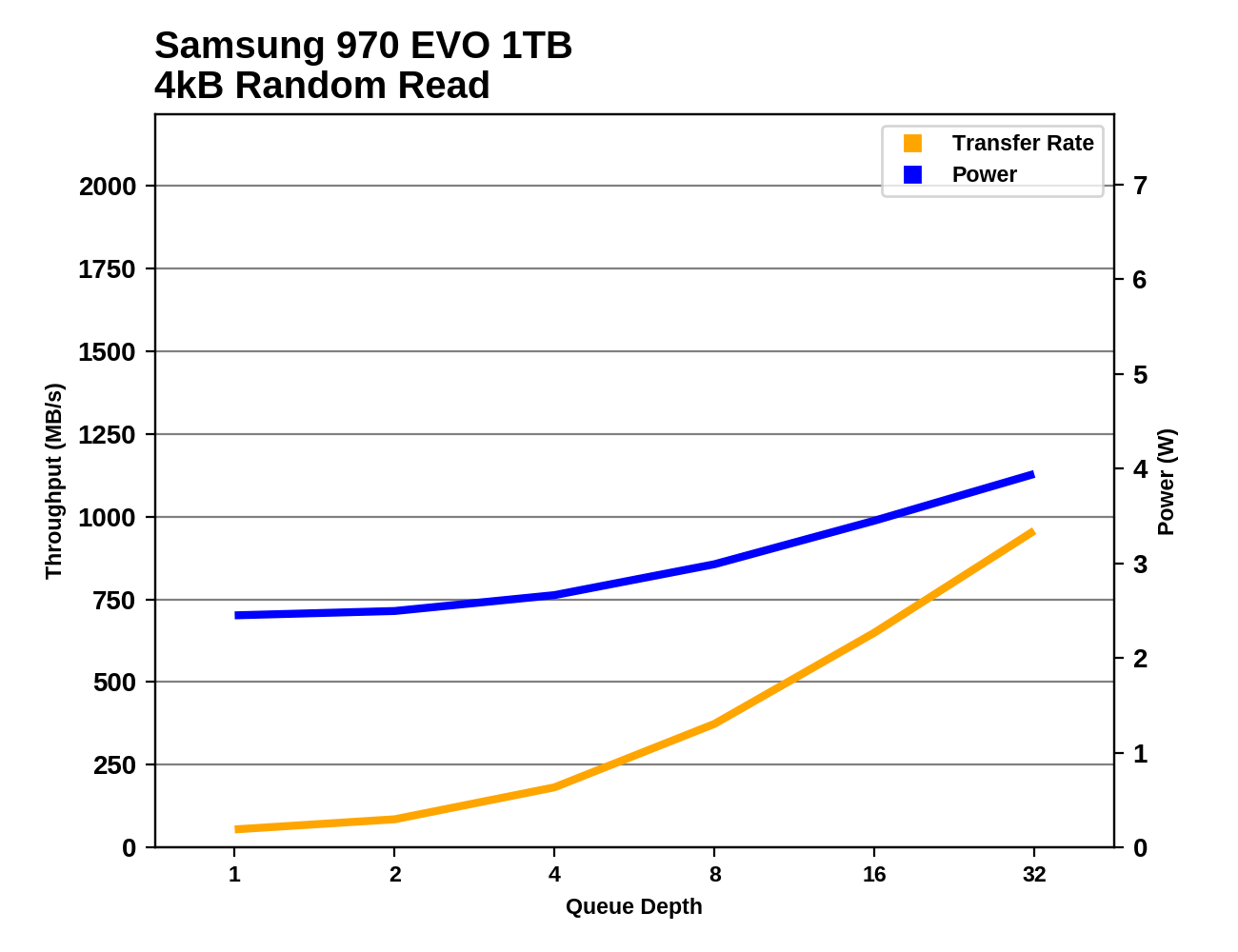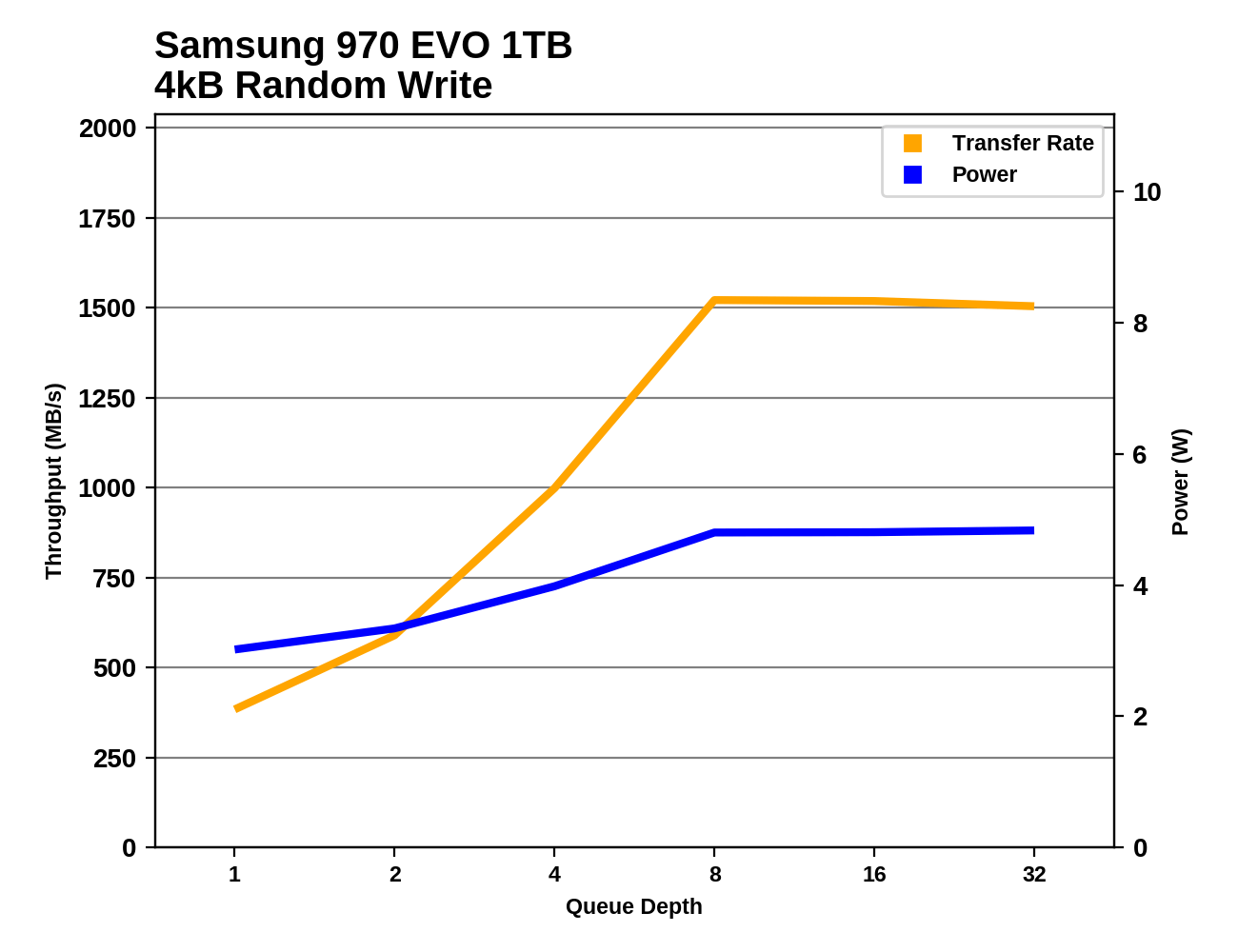The Mainstream Phoenix Rises: Samsung's 970 EVO (500GB & 1TB) SSDs Reviewed
by Billy Tallis on April 24, 2018 10:00 AM ESTRandom Read Performance
Our first test of random read performance uses very short bursts of operations issued one at a time with no queuing. The drives are given enough idle time between bursts to yield an overall duty cycle of 20%, so thermal throttling is impossible. Each burst consists of a total of 32MB of 4kB random reads, from a 16GB span of the disk. The total data read is 1GB.

The burst random read performance of the Samsung 970 EVO is the best they've ever delivered from TLC NAND flash memory, but the Intel SSD 760p is a few percent faster still.
Our sustained random read performance is similar to the random read test from our 2015 test suite: queue depths from 1 to 32 are tested, and the average performance and power efficiency across QD1, QD2 and QD4 are reported as the primary scores. Each queue depth is tested for one minute or 32GB of data transferred, whichever is shorter. After each queue depth is tested, the drive is given up to one minute to cool off so that the higher queue depths are unlikely to be affected by accumulated heat build-up. The individual read operations are again 4kB, and cover a 64GB span of the drive.

On the longer random read test, the Samsung 970 EVO proves to be the fastest TLC-based drive, but Samsung's MLC-based drives offer up to 20% higher performance.
 |
|||||||||
| Power Efficiency in MB/s/W | Average Power in W | ||||||||
The Samsung 970 EVO and its OEM sibling PM981 have the worst power efficiency of any recent high-end SSD during the random read test. The 970 EVO is drawing over 2.5W while Samsung's previous generation high end drives averaged less than 2W for very similar performance.
 |
|||||||||
The performance scaling of the 970 EVO is almost identical to that of the 960 EVO, but the 970 EVO draws more power throughout the random read test.
Random Write Performance
Our test of random write burst performance is structured similarly to the random read burst test, but each burst is only 4MB and the total test length is 128MB. The 4kB random write operations are distributed over a 16GB span of the drive, and the operations are issued one at a time with no queuing.

The burst random write performance from the Samsung 970 EVO is disappointing compared to the PM981, especially for the 1TB 970 EVO. Meanwhile, recent Intel and WD drives have been raising the bar with very fast SLC write caches.
As with the sustained random read test, our sustained 4kB random write test runs for up to one minute or 32GB per queue depth, covering a 64GB span of the drive and giving the drive up to 1 minute of idle time between queue depths to allow for write caches to be flushed and for the drive to cool down.

On the longer random write test, the 1TB PM981 provided top-tier performance, but the 1TB 970 EVO is about 12% slower, putting it on par with the previous generation from Samsung. The 500GB 970 EVO is also slightly slower than its PM981 counterpart.
 |
|||||||||
| Power Efficiency in MB/s/W | Average Power in W | ||||||||
Power efficiency has also regressed for the 970 EVO on the random write test, leaving it well below the standard set by the WD Black and the slower but similarly efficient Toshiba XG5.
 |
|||||||||
The random write performance of the 1TB 970 EVO tops out at just over 1.5 GB/s at queue depths of 8 and higher. The 500GB 970 EVO starts running out of SLC cache and showing inconsistent performance past QD4. The 1TB PM981 was able to ramp up performance much faster than the 970 EVO and hit a maximum of about 1.8GB/s before running out of SLC cache near the end of the test. The 512GB PM981 behaved very similarly to the 500GB 970 EVO.










68 Comments
View All Comments
mapesdhs - Sunday, May 6, 2018 - link
HollyDOL, as others have said, it very much depends on what you're doing. As a C-drive it simply helps to have any kind of SSD at all rather than a rust spinner (except of course the cheap junk knockoffs like Gloway). The Vertex3 was a pretty good SSD for its time (I have lots of them), though back then the Vertex4 presented its own significant bump up in benchmark performance, as did the Vector. For general use, you might notice some difference compared to an NVMe device, certainly in bootup times, but beyond that it depends on the task. Some games will certainly load a lot quicker, assuming the CPU/RAM are able to take advantage of it. And btw, some older mbds can have a mod BIOS installed to enable booting from NVMe (I'm more familiar with the options for ASUS boards in this regard), and certain NVMe SSDs even have their own boot ROM (eg. 950 Pro) such that native boot support isn't required.It's a good idea for video editing though, eg. the main cache/scratch drive for After Effects or Vegas.
Lolimaster - Tuesday, April 24, 2018 - link
Unless you work moving huge chunks of data (editing 4k for example) a lot there's no point going NVME over the Crucial MX500 sata.Death666Angel - Tuesday, April 24, 2018 - link
Especially in cramped cases, small form factor stuff, the gum stick is really nice because you don't need annoying cables around. My next MoBo will be some Ryzen thing in mATX with 2 M.2 slots (likely PCIe and SATA), so I can go all SSD for my desktop without any cables. I haven't noticed improvements after going to SATA3 SSDs from my Vertex/Agility first gen ones.iwod - Saturday, April 28, 2018 - link
I can't disagree more. SATA is limited in Seq speed. And it is actually a user observable difference in everyday use, between a 1.5 - 2GB/s and 600MB/s speed.Now whether that is worth a little more money you paid for is a different question.
peevee - Monday, April 30, 2018 - link
And how you are going to hit the seq speed in real life? All external (USB or network) sources and targets are slower. Writing does not matter with write-back OS caching. Reading a document into memory is limited by memory size and actually parsing/decompression of the document. Unless you are copying huge files between RAM drives and your SSD, you have no use case. That is why the tests are generating random data on the fly, like NOTHING does in real life. And that is why sites like AT have NO reproducible real-life tests (like compilation of a large software package for example, or recoding of video), as they would show about 0 real difference between drives 2x in price.mapesdhs - Sunday, May 6, 2018 - link
I see a nice difference when cloning my photo/video archive (1TB SM961), moving files around, network access, etc., to the extent I'm now looking into 10GigE.Lolimaster - Tuesday, April 24, 2018 - link
You don't see everyday benefits because the things that make SSD's faster than HDD's (access times, random 4k QD1 reads) barely improves from sata to nvme. Even with an optane SSD you won't see much improvement.Lolimaster - Tuesday, April 24, 2018 - link
1-SSD had 100x less access time vs HDD and 100x higher 4k random performance, NVME basically only improves on sustained transfer raters.Going from 5-10ms to 0.07ms and from 400KB/s to 40MB/s~ was a lot.
Cooe - Tuesday, April 24, 2018 - link
Yup. Without a doubt a good NVMe is much snappier, but you have to be the right kind of PC user for the difference to be that level of obvious. Even the heaviest applications, projects, etc... open instantly or near it vs the usual couple seconds, up to a minute or so for the really beefy crap with SATA-III, so if you're well familiar with PC's & in-tune with yours' level of performance, and are somebody who's regularly booting up, closing, and switching between multiple applications, storage heavy projects, etc... NVMe provides an obviously superior experience. And even if you aren't that kind of person yet, if you have compatible hardware the price gap has shrunk enough that I'd still recommend NVMe over SATA regardless as storage loads only ever increase with time. Aka you might not be the kind of person/PC user that can/will notice it now, but in a few years chances are that you most definitely will, and'll be glad you made the choice you did.For most lighter users atm otoh, SATA-III's already plenty fast enough for the workloads they regularly do. And that's on top of the fact that they simply don't have the level of "PC awareness" for the difference to stand out the way it does for heavy users and PC nerds like myself. And of course, even for us heavy users & multi-taskers who get real & significant benefits from the switch, it's still nothing on the order of the HDD to SATA SSD jump which is why those not well aware of their PC's current performance level and whom aren't heavy storage users (lots of regular & concurrent file access, movement, and modification) are rather likely to not notice the improvements w/o having them explictly pointed out (ala instantaneous or near it launches of most apps, even for multiples simultaneously vs delay's of a handful of seconds to a minute+ or so for the biggies, vastly improved file copy & movement speeds, ability to maintain SATA SSD levels of responsiveness while heavy storage workload(s) are active in the background, etc...)
Cliff34 - Tuesday, April 24, 2018 - link
For me, the higher premium prices for nvm ssd vs sata ssd is not worth for the performance gain. I'm sure a nvm ssd is faster but I don't want to shell out few hundreds dollars (comparing the 1td) more to have my computer a few seconds faster.